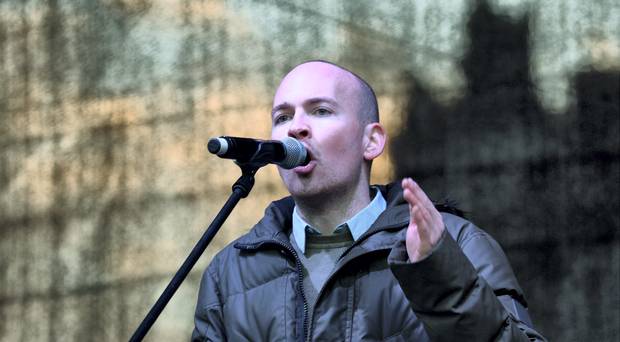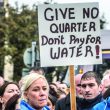by Paul Murphy TD
As well as holding the potential of dealing a decisive and confidence building blow to austerity, the anti-water charges movement has dramatically widened the space to build a new political force of the left. The protest movement has accelerated the radicalisation in Irish society under the impact of austerity, which has seen the traditional parties of Fianna Fáil, Fine Gael and Labour reduced to less than 50% in many opinion polls.
Shift to the left
Of the respondents to a survey conducted by Dr. Rory Hearne (‘The Irish water war, austerity and the ‘Risen people’) 31.7% said they would vote for the Anti-Austerity Alliance or the People Before Profit Alliance, while 27.5% would vote for ‘Left Independents’ and 23.9% for Sinn Féin. This confirms that where an active movement takes place, it is the forces of the active campaigning left which come to the fore amongst those who are active, whereas Sinn Féin, with its relatively passive approach, falls back.
In order to maximise the potential for a new political movement emerging from the struggle against water charges, it must be rooted in this day-to-day struggle. This means, at this crucial stage with bills dropping, openly calling for and actively organising for non-payment. This is necessary to maximise our chance of victory against the water charges, which will in turn open the political opportunities wider.
The necessity of struggle
It is also necessary as an illustration of what type of new political movement is being created. It should break with the traditional ‘electoralism’ of old social democratic parties, which is also the practice of Sinn Féin, where instead of empowering people, they are reduced to voting fodder. This approach would also chime with the majority surveyed in Dr. Hearne’s report, with 77.6% of the opinion that the most effective way of achieving change is through protesting, versus 52.3% seeing elections as most important.
It is essential that a new political movement is deeply democratic. A precondition for achieving real unity is space for debate, discussion and an ability to democratically take decisions. A new movement could start with in-depth discussions of anti-water charges movements in different local areas about this initiative. They could come together at a major national conference with delegates elected from different campaigns around the country. Such a conference could democratically decide on a programme and strategic approach. Different political, community and trade union groups that take part could retain their own identity as part of this broader project, and their right to put forward their own ideas and programme publicly and within the movement.
No coalition with establishment parties
A new movement must also clearly point towards an alternative to the austerity status quo. This means avoiding the mistaken logic of coalitionism. Going into coalition with traditional establishment parties has always resulted in demoralisation and disappointment for working class people and setbacks for the left. The history of the Irish Labour party demonstrates this clearly, as do examples from around the world, perhaps most graphically when Rifondazione Communista joined the second Prodi government in 2006, which led to betrayal of its principles and the effective collapse of what had been a party of 100,000 members. A bottom line therefore must be a clear ruling out of going into government with Fianna Fáil, Fine Gael or Labour.
Break with logic of austerity
Linked to that, is a need for a clear programme to break with austerity. That means a definite commitment to a strategy of repudiation of the bankers’ debts, to major public investment to create decent jobs, to reverse austerity measures through taxation of the corporations, wealthy and high earners. It also means putting forward a vision of breaking with the rule of profit and building a fundamentally different model of economic growth – a sustainable one built on public ownership and democratic control of the key sectors of the economy.
A left movement based on this anti-capitalist and socialist approach, combined with the energy of the anti-water charges movement and a democratic structure to allow mass participation, could inspire thousands to get involved and quickly become a powerful weapon for fundamental change.












